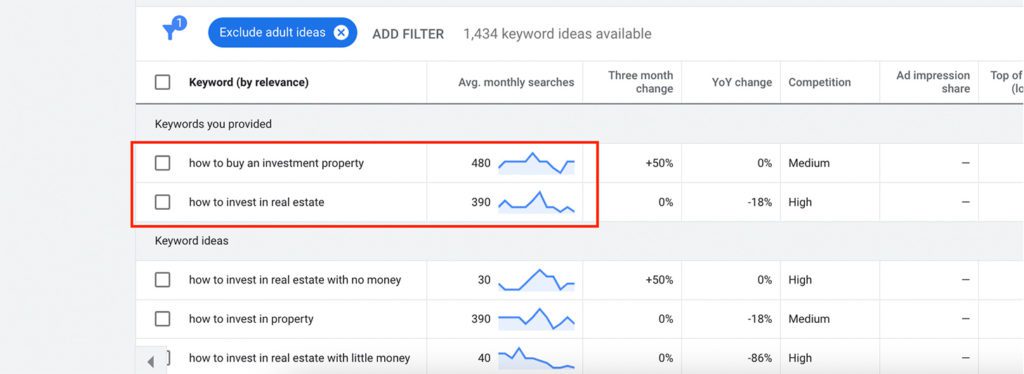First of all, what is video content marketing?
Video content marketing is the idea of creating and sharing videos to help your business grow and generate leads. It’s a great way to get your products, services and expertise in front of potential customers.
Video content can be a great way to build your brand and tell your story. That’s why it’s important to publish videos consistently and on a specific topic.
Using a platform like YouTube will allow you to be found by your target audience when they are searching for specific keywords that pertain to your business area. This is because they will be searching within the platform, or directly from Google search, and your video will be displayed to them based on your keyword.
For example, a local real estate agent could create a series of videos around the subject of buying an investment property.
As a matter of fact, keywords such as
- “how to buy an investment property”
- “how to invest in real estate”
have high average monthly searches (source: Google Ads) and provide a good opportunity to be found online.

In order to be effective, video content marketing must be consistent. That’s why you should schedule your videos and post them on a regular basis so that you get an audience and keep them coming back for more.
Overtime, some of your video audience will become real customers. This is a great goal to have, and it doesn’t have to happen immediately. However, you can build a strong relationship with your audience over time by consistently creating and sharing high-quality video content.
The process
Now, let’s take a look at how you can get video content marketing up and running for your business.
- Find your topic
- Find your keywords
- Create a content production book
- Create your first script
- Create your first video
- Publish your first video
- Keep publishing
- Watch your audience grow
1. Find your topic
One of the first steps when creating video content is finding your topic. The topic will be the main focus of your videos, so it’s important to choose something that you’re an expert on, and that you’re passionate about.
Your business has invaluable insights on the topic, and you should be sharing them with the world, so the world can see you as a resource of useful information.
2. Find your keywords
You, or your marketing team, likely already have a list of keywords that your target audience is looking for. Compile them into a list of potential keywords that you would like to turn into videos. You should plan for one video per keyword.
For example, a local Sydney entertainment agency could create a list of keywords similar to the one below:
- best sydney pubs
- best pub food sydney
- best beer gardens sydney
- things to do friday night sydney
- things to do saturday night sydney
…and so on
People are looking for this kind of information, and if you can provide it in a fun way, from an expert point of view, and with an engaging video, you will gain a great deal of traffic. And some of this traffic will eventually convert into business.
3. Create a content production book
It’s important to plan your video production content, and a spreadsheet can help you keep things organised and clean.

You can view and download this Video Content Marketing Production Book Template here.
Place all your keywords into this spreadsheet, so you can find them later, and start noting down production dates, links to scripts, footage and other assets, publishing deadlines etc.
The production book can also serve as a great tool for your marketing team, so they can keep track of things and share new content ideas, review drafts etc.
4. Create your first script
For your first videos, we recommend that you start with a written script, or, if you already have a blog, you could transform one of your blog posts into a video script.
Either way, a script will help you deliver your message on camera better, especially if you’re camera shy, or not camera trained.
5. Create your first video
Your first video can be recorded using a phone or a simple camera. For video content marketing to be effective, you don’t necessarily need to produce super high quality video. The content is what matters! Make sure you are offering high value insights into your audience’s needs, and you’ll be successful. Over time, your video production skills will get better, and your videos will also look better.
If you’re not entirely familiar with the process of creating a YouTube video, here’s a step by step guide from our very own personal experience.
If you do feel like you need a professional videographer to help you with your content production, a cost effective way to go about this is to put together scripts and content for a number of videos and hire someone to shoot them all in one session. This will save you a ton of money, and will allow you to produce a bunch of videos in just one day.
Then there’s the editing, which again, at the beginning doesn’t need to be super fancy. There are plenty of options out there, and plenty of help. Start with your marketing team, they might be able to edit the video for you, or hire someone online (Fiverr and Upwork are a good place to start).
6. Publish your first video
Creating a YouTube channel is easy, and it can be done in just a few minutes. Again, we recommend YouTube for its popularity, and also because being part of the Google family, it will make it easier for your videos to be found not only inside the platform, but also directly from Google search.
Once done, upload your first video, give your video a title (make sure you include the target keyword in the title, for SEO reasons), write a description and put a link to your business website.
Also, now that your business has a YouTube channel, why not add a link from your website, or social media page, to your new YouTube channel.
AND… you can embed the video in your website, as a blog post, including the script as the text body, and share this on Facebook, Instagram, Linkedin or whatever social media platform you’re using.
Your video can also be used to promote your business in an email marketing campaign, IF you already have an email list. This way, you might be able to boost your views and channel subscriptions immediately, without waiting on the algorithm.
7. Keep publishing
Once you’ve published your first video, you will have a better idea of how much work is involved in the creation process, and you can then decide how many more videos you can deploy each year, based on your resources, time and budget.
Tip: start slow, and then increment as you become more confident. Starting with a weekly publishing schedule to then find out that it’s not sustainable is not a good way to go with it. On the contrary, if your audience is used to a monthly video from your business, and then at some point you start publishing more often, they’ll be more than happy to keep watching.
8. Watch your audience grow
As you produce more and more videos, your audience will inevitably grow overtime, it’s a fact. From there, and once you’re confident that your business is publishing great videos, you can decide if you want to grow organically only, or if you want to build a PPC campaign based on your video content, to reach more people and grow your followers more rapidly.













